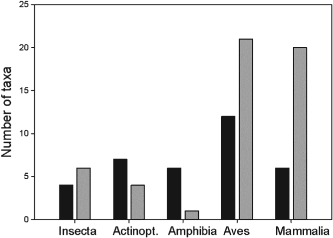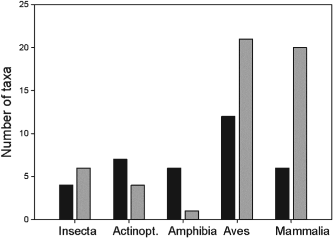The paper provides a review and synthesis examining the occurrence of source and sink populations in the literature. Pullman (1988) stated that sink habitats would need inputs from nearby sources to persist in the landscape. As the need for conservation planning increases, a better understanding of what may affect the presence of source and sink habitats is crucial. Prior to performing the analysis, the authors provide systematic and biological predictions about what may influence source and sink population occurrence.
Methodological:
- There will be less evidence for source populations then sink population.
- The authors were correct in this prediction there was more evidence for sink populations across taxa (however, this finding was not significant, p=0.059).


Black bars represent source populations. Grey bars are sink populations.
- The spatial scale of the studies will affect the detection/occurance of source and sink populations.
- Was not supported.
- When several, i.e. more than a few(?), local populations are considered, there will be more evidence for source populations.
- Was not supported.
- The authors comment that more demographic data should be record when examining populations (i.e. fecundity/mortality, immigration/emmigration).
Biological
- More sources are expected when the local population is stable or increasing. Sinks when the local population is decreasing.
- Was not supported.
- Sources are expected in resident species rather than migratory.
- Was not supported.
- Low-dispersal ability species are expected to have more sources than high dispersal ability species. Also, high dispersing species are expected to have more sinks than limited dispersal species.
- Was not supported.
- Well-connected local populations are expected to have more sources.
- The prediction was supported, local populations that were well-connected were more likely to have sources. Immigration between may prevent stochastic/demographic extinction of patches.
- Specialist species, that can only utilize a limited range of environmental conditions, are expected to have more sink habitats.
- Was not supported
- Sources were expected to occur more often in the middle of species ranges, with sinks occurring on the edge.
- Was not supported.
Furrer, R. D. & Pasinelli, G. 2015 Empirical evidence for source–sink populations: a review on occurrence, assessments and implications. Biol. Rev.
